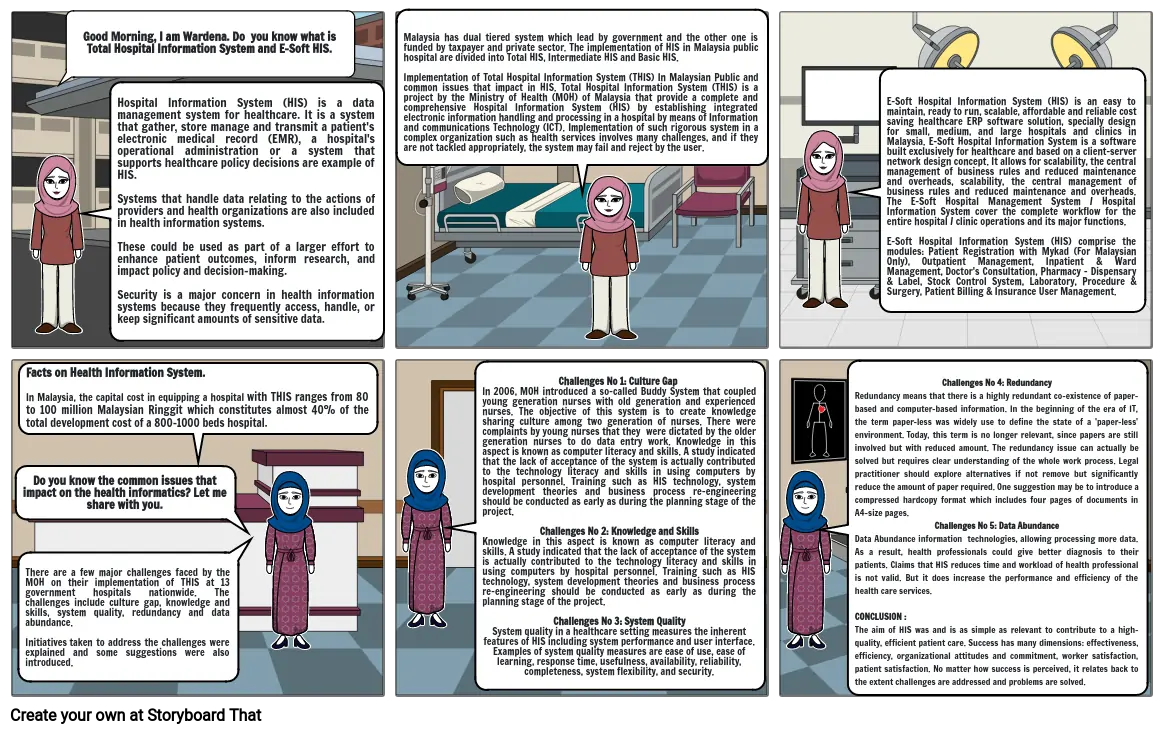E-Soft Total Hospital Information System

Text z Príbehu
- Good Morning, I am Wardena. Do you know what is Total Hospital Information System and E-Soft HIS.
- Hospital Information System (HIS) is a data management system for healthcare. It is a system that gather, store manage and transmit a patient's electronic medical record (EMR), a hospital's operational administration or a system that supports healthcare policy decisions are example of HIS.Systems that handle data relating to the actions of providers and health organizations are also included in health information systems. These could be used as part of a larger effort to enhance patient outcomes, inform research, and impact policy and decision-making. Security is a major concern in health information systems because they frequently access, handle, or keep significant amounts of sensitive data.
- Malaysia has dual tiered system which lead by government and the other one is funded by taxpayer and private sector. The implementation of HIS in Malaysia public hospital are divided into Total HIS, Intermediate HIS and Basic HIS.Implementation of Total Hospital Information System (THIS) In Malaysian Public and common issues that impact in HIS. Total Hospital Information System (THIS) is a project by the Ministry of Health (MOH) of Malaysia that provide a complete and comprehensive Hospital Information System (HIS) by establishing integrated electronic information handling and processing in a hospital by means of Information and communications Technology (ICT). Implementation of such rigorous system in a complex organization such as health services involves many challenges, and if they are not tackled appropriately, the system may fail and reject by the user.
- E-Soft Hospital Information System (HIS) is an easy to maintain, ready to run, scalable, affordable and reliable cost saving healthcare ERP software solution, specially design for small, medium, and large hospitals and clinics in Malaysia. E-Soft Hospital Information System is a software built exclusively for healthcare and based on a client-server network design concept. It allows for scalability, the central management of business rules and reduced maintenance and overheads, scalability, the central management of business rules and reduced maintenance and overheads. The E-Soft Hospital Management System / Hospital Information System cover the complete workflow for the entire hospital / clinic operations and its major functions. E-Soft Hospital Information System (HIS) comprise the modules: Patient Registration with Mykad (For Malaysian Only), Outpatient Management, Inpatient & Ward Management, Doctor's Consultation, Pharmacy - Dispensary & Label, Stock Control System, Laboratory, Procedure & Surgery, Patient Billing & Insurance User Management.
- Do you know the common issues that impact on the health informatics? Let me share with you.
- There are a few major challenges faced by the MOH on their implementation of THIS at 13 government hospitals nationwide. The challenges include culture gap, knowledge and skills, system quality, redundancy and data abundance.Initiatives taken to address the challenges were explained and some suggestions were also introduced.
- Facts on Health Information System.In Malaysia, the capital cost in equipping a hospital with THIS ranges from 80 to 100 million Malaysian Ringgit which constitutes almost 40% of the total development cost of a 800-1000 beds hospital.
- Challenges No 1: Culture Gap In 2006, MOH introduced a so-called Buddy System that coupled young generation nurses with old generation and experienced nurses. The objective of this system is to create knowledge sharing culture among two generation of nurses. There were complaints by young nurses that they were dictated by the older generation nurses to do data entry work. Knowledge in this aspect is known as computer literacy and skills. A study indicated that the lack of acceptance of the system is actually contributed to the technology literacy and skills in using computers by hospital personnel. Training such as HIS technology, system development theories and business process re-engineering should be conducted as early as during the planning stage of the project.Challenges No 2: Knowledge and SkillsKnowledge in this aspect is known as computer literacy and skills. A study indicated that the lack of acceptance of the system is actually contributed to the technology literacy and skills in using computers by hospital personnel. Training such as HIS technology, system development theories and business process re-engineering should be conducted as early as during the planning stage of the project.Challenges No 3: System QualitySystem quality in a healthcare setting measures the inherent features of HIS including system performance and user interface. Examples of system quality measures are ease of use, ease of learning, response time, usefulness, availability, reliability, completeness, system flexibility, and security.
- Challenges No 4: RedundancyRedundancy means that there is a highly redundant co-existence of paper-based and computer-based information. In the beginning of the era of IT, the term paper-less was widely use to define the state of a 'paper-less' environment. Today, this term is no longer relevant, since papers are still involved but with reduced amount. The redundancy issue can actually be solved but requires clear understanding of the whole work process. Legal practitioner should explore alternatives if not remove but significantly reduce the amount of paper required. One suggestion may be to introduce a compressed hardcopy format which includes four pages of documents in A4-size pages.Challenges No 5: Data AbundanceData Abundance information technologies, allowing processing more data. As a result, health professionals could give better diagnosis to their patients. Claims that HIS reduces time and workload of health professional is not valid. But it does increase the performance and efficiency of the health care services.CONCLUSION :The aim of HIS was and is as simple as relevant to contribute to a high-quality, efficient patient care. Success has many dimensions: effectiveness, efficiency, organizational attitudes and commitment, worker satisfaction, patient satisfaction. No matter how success is perceived, it relates back to the extent challenges are addressed and problems are solved.
Bolo vytvorených viac ako 30 miliónov storyboardov

